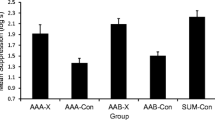Inhibition of attention to irrelevant stimuli was studied in SHR rats using latent inhibition test. Latent inhibition was formed in two types of conditioned tasks with different levels of complexity and stress. Passive and active avoidance conditioning was preceded by preexposure to conditioned stimulus consisting of 20 and 100 non-reinforced presentations, respectively. Control Wistar rats demonstrated successful formation of latent inhibition in both tasks. SHR rats showed different degree of disruption of latent inhibition depending on the type of behavioral task. We assume that learning defect in these animals in respect to both novel and preexposed conditioned stimuli is associated with the lack of behavioral inhibition.
Similar content being viewed by others
References
L. V. Loskutova, A. V. Filatov, N. I. Dubrovina, A. L. Markel, Ross. Fiziol. Zhurn., 92, No. 4, 440–448 (2006).
L. V. Loskutova, A. V. Filatov, N. I. Dubrovina, A. L. Markel, Bull. Eksp. Biol. Med., 142, No. 10, 386-388 (2006).
M. B. Calzavara, W. A. Medrano, R. Levin, et al., Schiz. Bull., 35, No. 4, 748–759 (2009).
K. M. Kantak, T. Singh, K. A. Kerstetter, et al., Behav. Neurosci., 122, No. 2, 340–357 (2008).
R. E. Lubow, Schizophr. Bull., 31, No. 1, 139–153 (2005).
R. E. Lubow, H. Braunstein-Bercovitz, O. Blumenthal, et al., Child Neuropsychol., 11, No. 5, 445–457 (2005).
R. D. Oades, A. G. Sadile, T. Sagvolden, et al., Develop. Sci., 8, No. 2, 122–131 (2005).
F. A. Pamplona, P. Pandolfo, R. Savoldi, Prog. Neuropsychopharm. Biol. Psychiatry., 33, No. 7, 1153–1160 (2009).
R. D. Prediger, D. Fernandes, R. N. Takahashi, Behav. Brain Res., 159, No. 2, 197–205 (2005).
T. Sagvolden, E. B. Johansen, H. Aase, V. A. Russel, Behav. Brain Sci., 28, No. 3, 397–419 (2005).
S. J. Suskauer, D. J. Simmonds, S. Fotedar, et al., J. Cogn. Neurosci., 20, No. 3, 478–493 (2008).
I. Weiner, Psychopharmacology (Berl.), 169, Nos. 3–4, 257–297 (2003).
Author information
Authors and Affiliations
Corresponding author
Additional information
Translated from Byulleten’ Eksperimental’oi Biologii i Meditsiny, Vol. 153, No. 1, pp. 4-7, January, 2012
Rights and permissions
About this article
Cite this article
Kostyunina, N.V., Loskutova, L.V. Peculiarities of Latent Inhibition Formation in SHR Rats in Conditioned Task of Different Complexity. Bull Exp Biol Med 153, 1–4 (2012). https://doi.org/10.1007/s10517-012-1628-5
Received:
Published:
Issue Date:
DOI: https://doi.org/10.1007/s10517-012-1628-5



